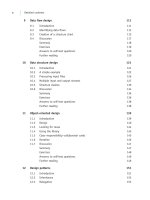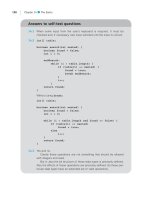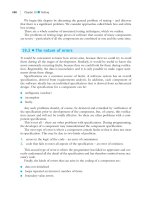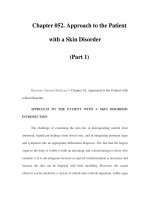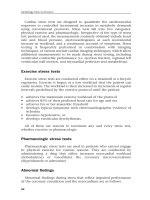Cardiology Core Curriculum A problem-based approach - part 1 potx
Bạn đang xem bản rút gọn của tài liệu. Xem và tải ngay bản đầy đủ của tài liệu tại đây (894.38 KB, 60 trang )
Cardiology Core Curriculum
A problem-based approach
Cardiology Core
Curriculum
A problem-based approach
Edited by
John D Rutherford
Cardiologist, Vice President of Clinical Operations, Professor of Internal
Medicine, Gail Griffiths Hill Chair in Cardiology, UT Southwestern
Medical Center, Dallas, Texas, USA
© BMJ Publishing Group 2003
BMJ Books is an imprint of the BMJ Publishing Group
All rights reserved. No part of this publication may be reproduced, stored in
a retrieval system, or transmitted, in any form or by any means, electronic,
mechanical, photocopying, recording and/or otherwise, without the prior
written permission of the publishers.
First published in 2003
by BMJ Books, BMA House, Tavistock Square,
London WC1H 9JR
www.bmjbooks.com
British Library Cataloguing in Publication Data
A catalog record for this book is available from the British Library
ISBN 0 7279 1690 4
Typeset by SIVA Math Setters, Chennai, India
Printed and bound in Spain by Graphycems, Navarra
Contents
Contributors vii
Preface xi
1 Cardiac history and examination 1
Tayo Addo, John D Rutherford
2 Cardiac non-invasive imaging and stress testing 28
Victor A Ferrari, Luis Araujo, Martin G St John Sutton
3 Cardiac catheterization 74
Charles Landau
4 Hypertension 121
Sharon C Reimold
5 Lipid disorders 155
Daniel B Friedman
6 Acute coronary syndromes 174
James A de Lemos
7 Chronic ischemic heart disease 205
Rao H Naseem, Michael L Main, John D Rutherford
8 Arrhythmias 235
David J Kessler, Richard L Page
9 Sudden cardiac death and resuscitation 268
Robert C Kowal
10 Heart failure and cardiac transplantation 278
Clyde W Yancy Jr
11 Congenital heart disease 323
M Elizabeth Brickner
12 Valvular disease and infective endocarditis 357
John A Bittl
13 Pericardial disease, disease of the aorta, and heart tumors 404
John A Osborne, Leonard S Lilly
v
14 Pulmonary embolism and pulmonary hypertension 445
Samuel Z Goldhaber
15 Non-cardiac surgery in patients with heart disease 476
Thomas H Lee
16 Heart disease in pregnancy 504
John D Rutherford
17 Cardiovascular pharmacology 523
Carlos M Sotolongo, James D Marsh
18 Arterial vascular disease 560
Khether E Raby
Index 597
Cardiology Core Curriculum
vi
Charles Landau
Assistant Professor of Clinical Medicine, Columbia University, College
of Physicians and Surgeons, Cardiologist, Cardiac Associates of Southern
Connecticut, Bridgeport, Connecticut, USA
Thomas H Lee
Chief Medical Officer, Partners Community Healthcare, Inc.,
Associate Professor of Medicine, Harvard Medical School, Boston,
Massachusetts, USA
Leonard S Lilly
Cardiologist, Chief, Brigham and Women’s/Faulkner Cardiology,
Associate Professor of Medicine, Harvard Medical School, Boston,
Massachusetts, USA
Michael L Main
Consulting Cardiologist, Mid America Heart Institute, Kansas City,
Missouri, USA
James D Marsh
Cardiologist, Chief, Division of Cardiology, Professor and Associate
Chair for Research, Department of Internal Medicine, Wayne State
University, Detroit, Michigan, USA
Rao H Naseem
Cardiology Fellow, UT Southwestern Medical Center, Dallas, Texas,
USA
John A Osborne
Cardiologist, Dallas, Texas, USA
Richard L Page
Cardiologist, Head, Division of Cardiology, Robert A Bruce Professor
of Medicine, University of Washington School of Medicine, Seattle,
Washington, USA
Khether E Raby
Cardiologist, Assistant Professor of Clinical Medicine, Boston
University School of Medicine, Massachusetts, USA
Sharon C Reimold
Cardiologist, Medical Director, UT Southwestern Clinical Heart
Center, Associate Professor of Internal Medicine, UT Southwestern
Medical Center, Dallas, Texas, USA
John D Rutherford
Cardiologist, Vice President of Clinical Operations, Professor of
Internal Medicine, Gail Griffiths Hill Chair in Cardiology, UT
Southwestern Medical Center, Dallas, Texas, USA
Cardiology Core Curriculum
viii
Contributors
ix
Carlos M Sotolongo
Cardiologist, Diagnostic Cardiology, PA Jacksonville, Florida, USA
Martin G St John Sutton
Cardiologist, Director, Cardiovascular Imaging Program, Hospital
of the University of Pennsylvania, John Bryfogle Professor of
Cardiovascular Diseases, University of Pennsylvania Health System,
Philadelphia, Pennsylvania, USA
Clyde W Yancy Jr
Cardiologist, Medical Director of Heart Failure and Cardiac Transplant
Program, Associate Professor of Medicine, Carl H Westcott
Distinguished Chair in Medical Research and Dallas Heart Ball Chair in
Cardiac Research, UT Southwestern Medical Center, Dallas, Texas, USA
Christina Karaviotis, Lotika Singha and Andy Baker of BMJ Books for
their advice, support, and the rapid response to trans-Atlantic emails
and attachments. For administrative support I remain indebted to
Shirley Crook and Doris Matthews.
John D Rutherford
UT Southwestern Medical Center
Dallas, Texas
Cardiology Core Curriculum
xii
history should uncover risk factors that predispose to coronary artery
disease. In general, angina pectoris will tend to occur in males over
40 years of age and females over 50 years of age; a history of cigarette
smoking is common, and the presence of diabetes mellitus,
hypertension, hypercholestrolemia, or peripheral vascular disease
is highly relevant. Similarly, a prior history of myocardial infarction,
or a family history of myocardial infarction or sudden death in a male
parent or sibling before age 55 years, or a female parent or sibling
before age 65 years is important.
Palpitations may be reported by patients as sensations of flipping,
stopping, pounding, or fluttering of their heart. Abrupt onset and
offset of rapid, sustained palpitations suggests supraventricular or
ventricular tachycardia. If the sensation associated with the
palpitations is accompanied by dizziness, presyncope, or syncope,
then ventricular tachycardia needs to be excluded. If rapid irregular
rhythms are reported then atrial fibrillation or flutter or tachycardia
with varying block are suggested. Palpitations arising during exercise
or in situations of catecholamine excess may be due to ventricular
tachycardia arising from the right ventricular outflow tract, and those
that arise immediately after exercise may be due to atrial fibrillation
and a relative increase in vagal tone. A family history of premature
death or arrhythmias is highly relevant. When acquiring the history
it can be helpful if the patient can tap out, with their fingers, their
perception of normal rhythm and the rhythm associated with their
symptoms. (A 12-lead electrocardiogram taken during the abnormal
rhythm can be diagnostic. An electrocardiogram taken in normal
sinus rhythm can give clues as to the possible primary diagnosis. For
Cardiology Core Curriculum
2
Table 1.1 Severity of angina (Canadian Cardiovascular Society)
Severity of angina Features
Class I Angina does not occur with ordinary physical
activity; it occurs only with strenuous or
prolonged exertion
Class II Slight limitation of ordinary activity; angina occurs
with rapid walking on level ground or up inclines
or steps
Class III Marked limitation or ordinary physical activity;
angina occurs when walking
Class IV Inability to carry out even mild physical activity
without angina, which also may occur briefly
at rest
Adapted from Campeau
1
example, a short PR interval and δ waves suggest pre-excitation and
supraventricular tachycardia; left ventricular hypertrophy, atrial
premature beats, or P-wave abnormalities of mitral valve disease may
represent substrates for atrial fibrillation; Q waves of prior myocardial
infarction may be the substrate for ventricular arrhythmias; and a
long QT interval is possibly associated with polymorphic ventricular
tachycardia.
2
)
Shortness of breath, or dyspnea, is a normal accompaniment of
physical exertion and is accentuated by obesity, pregnancy, lack of
physical fitness, and advanced age. Normally, shortness of breath
limits exercise performance, or physical activity, and individuals have
a certain expectation of what is normal for them. The shortness of
breath caused by heart disease is similar to that caused by normal
exertion, but it is provoked by lower levels of physical activity than
has been experienced previously by the individual patient. New
symptoms of nocturnal cough or episodic difficulty with breathing
when lying supine may also be associated with cardiac dysfunction.
Anxious patients may at times experience the sensation that a deeper
breath than normal is required to feel comfortable but have normal
breathing with physical activity. The clinician must listen carefully to
the description provided by the patient and decide whether the
symptoms fall into a normal or abnormal category.
Appearance of the patient
The patient may appear to be breathless at rest, which suggests the
presence of heart failure or severe pulmonary disease. The appearance
of a patient may suggest specific systemic or developmental disorders.
For example, in Marfan’s syndrome there is a defect in the region of
chromosome 15 that encodes the connective tissue protein fibrillin-1;
this defect is associated with a well recognized phenotype, including tall
stature, joint hypermobility, pectus excavatum, and arachnodactyly.
Rarely, arterial pulsations may be immediately obvious after looking
at a patient. For example, prominent arterial pulsations might be seen
in the neck or the patient’s head may be bobbing with each heart
beat, possibly indicating the presence of wide pulse pressures as are
seen in conditions such as severe aortic regurgitation.
Examination of the skin and mucous membranes is important
(Table 1.2). The presence of pale, cool extremities might suggest
circulatory insufficiency; the presence of warm extremities with
perspiration might suggest increased sympathetic activity (for example,
associated with hyperthyroidism) and dry mucous membranes might
suggest volume depletion. The patient may exhibit obvious edema,
Cardiac history and examination
3
Table 1.2 Skin and mucous membrane manifestations of car
diac disease
Skin manifestation Details
Associations
Cyanosis
Digital clubbing
Erythema nodosum
Facial edema
Bluish discoloration of the skin or mucous membranes
might suggest cyanosis, which is usually due to an
increased quantity of reduced hemoglobin in the
blood
Clubbing of the fingers is associated with a wide
variety of diseases or may be a congenital
abnormality.
3
(The distal part of the finger, including
the nail itself, is deformed, and there is swelling and
increased sponginess of the tissues overlying the
dorsum of the distal phalanx. The shape of the finger
is altered so that the widely obtuse angle between
the plane of the skin over the nail root and the nail
plate itself is filled in)
Red, raised, tender lesions on shins or forearms
Central cyanosis is associated with a decreased
arterial oxygen saturation, either due to right to left
shunting of the blood associated with congenital
heart disease or to abnormal pulmonary function.
Peripheral cyanosis is usually secondary to
cutaneous vasoconstriction, low cardiac output, and
high oxygen extraction or exposure to cold air or
water. Rarely, a patient will have deferential cyanosis
confined to the lower half of the body, possibly
indicating a right to left shunt through a patent
ductus arteriosus in association with an aortic arch
abnormality or aortic coarctation
The commonest cardiac cause is hypoxemia
associated with congenital heart disease and right to
left shunting. It is seen with chronic infection due to
subacute bacterial endocarditis and bronchiectasis.
Other important causes include pulmonary
malignancy and inflammatory gastrointestinal
disorders (Crohn’s disease and ulcerative colitis)
Non-specific allergic reaction to antigens, including
rheumatic fever and endocarditis
The presence of facial edema may suggest obstruction
of venous return to the heart (superior vena cava
obstruction) or constrictive pericarditis
Continued
Table 1.2 Continued
Skin manifestation Details
Associations
Osler’s nodes
Rheumatic nodules
Splinter
hemorrhages
Xanthomas
Hemochromatosis
Lentigines
Telangiectasias
Arachnodactyly
Quincke sign
Janeway lesions
Small, red, tender lesions in pulp of fingers and toes
and on palms and soles. They fade and become
painless over several days
Painless, mobile, subcutaneous lesions about 1 cm
around elbows, knees, and knuckles
Minute, longitudinal hemorrhages that appear like
splinters under the nail beds
Cholesterol-filled nodules found over tendons or
subcutaneously
Bronze pigmentation of skin and loss of pubic and
axillary hair
Small brown macular lesions on neck and trunk seen
first in childhood
Multiple capillary hemangiomas of skin, lips, nasal
mucosa, and upper respiratory and gastrointestinal
tracts
Systolic flushing of nail beds seen by pressing a light
against terminal digits
Non-tender, slightly raised hemorrhagic lesions in
palms and soles of feet
Transient embolic lesions seen with infective
endocarditis
Rheumatic fever and rheumatoid arthritis
Embolic phenomena of infective endocarditis or
traumatic
Eruptive xanthomas are small, yellow, 1–2 mm nodules
on an erythematous base found in types I and V
hyperlipoproteinemia. Tendinous xanthomas are
found in type II hyperlipoproteinemia
Associated with cardiomyopathy due to iron deposits in
heart
Pulmonary stenosis and hypertrophic cardiomyopathy
Can cause pulmonary arteriovenous fistulas and be
associated with central cyanosis
Marfan’s syndrome
Wide pulse pressure (for example, aortic regurgitation)
Infective endocarditis
especially of the lower extremities, due to hepatic, renal, or cardiac causes,
including congestive heart failure and constrictive pericardial disease.
Examination of the optic fundi may provide direct information on
a variety of conditions that affect the cardiovascular system. In
patients with hypertension the retinal changes are classified
according to the Keith–Wagner–Barker method. These changes reflect
both atherosclerotic and hypertensive retinopathy. Initially, arterial
narrowing is seen (grade 1), and subsequently the arteriolar diameters
increase in relation to the venous diameters, manifested as
arteriovenous nicking (grade 2 changes). As uncontrolled
hypertension progresses, small vessels rupture, and exudates and
hemorrhages are seen (grade 3 changes). Eventually, sustained,
accelerated, or extreme hypertension is associated with raised
intracranial pressure seen as papilledema, usually associated with
retinal exudates and hemorrhages (grade 4 changes). Grade 2 changes
correlate with other evidence of clinical cardiovascular disease or end-
organ damage (left ventricular hypertrophy, renal disease, arterial
disease). Overall risk in patients with hypertension correlates with
presence, or absence, of conventional cardiovascular risk factors and
evidence of uncontrolled hypertension or end-organ damage. In
patients with diabetes mellitus (an important cardiovascular risk
factor) retinopathy may develop. Increased capillary permeability
leads to capillary closure and dilatation, microaneurysms, and dilated
veins. Cotton wool spots (microinfarcts), hemorrhages, and hard
exudates are seen. New vessel formation and scarring are seen with
proliferative retinopathy. Finally, in infective endocarditis evidence of
focal retinal hemorrhage (i.e. Roth spots – retinal hemorrhage with a
clear center) or embolic phenomena (retinal arterial occlusion) may
be found.
Arterial blood pressure and pulses
Blood pressure should initially be measured in both arms. The
blood pressure is obtained by sphygmomanometry, and the bladder
associated with the cuff should encircle and cover approximately 50%
of the length of the upper arm. (If the cuff bladder is too small then
inaccurate, abnormally high blood pressure readings may be
obtained.) The cuff is inflated rapidly while palpating the pulse until
about 20–30 mmHg above the point at which the palpated radial
pulse disappears. The cuff is then deflated slowly as the brachial artery
is auscultated. The sounds heard are described in five phases
(Korotkoff sounds). The initial phase (phase 1) begins with the
appearance of clear, tapping sounds and represents systolic blood
Cardiology Core Curriculum
6
pressure. Diastolic blood pressure is represented by the disappearance
of sounds (phase 5). Just before the sounds disappear they become
muffled (phase 4). A discrepancy between blood pressures measured
in both arms (of more than 5–10 mmHg) may indicate involvement
of the great arteries leaving the heart, in a disease process (arterial
occlusive disease, aortic dissection or coarctation).
The major arterial pulses (carotid, brachial, radial, femoral,
popliteal, posterior tibial, and dorsalis pedis) should be examined
bilaterally. Diminished or absent arterial pulses suggest occlusive
disease. The radial and femoral arteries should be palpated
simultaneously during the cardiovascular examination. A significant
radial–femoral delay (the appearance of the pulses in the lower
extremities is delayed as compared with that in the upper extremities)
suggests coarctation of the aorta, which needs exclusion. In this
instance, an initial step is to measure blood pressures in the lower
extremities and compare them with pressures in the upper
extremities. Again, if there is a major discrepancy (i.e. the blood
pressures measured in the lower extremities are lower) then
coarctation of the aorta must be excluded.
When the arterial pulse is palpated (typically in the radial, carotid,
and brachial locations initially), rate, rhythm, and quality of the pulse
are noted. The rhythm may be regular or irregular. Sinus arrhythmia,
a normal finding, may be noted when there is a slight acceleration of
the pulse during inspiration and slowing during expiration. This
determination can usually be made only when the pulse is relatively
slow. An irregularly irregular pulse suggests atrial fibrillation, and
occasional dropped or skipped beats may suggest atrial or ventricular
premature beats. A rhythm strip, or a 12-lead electrocardiogram, is the
only sure way to distinguish these irregularities. The shape of the
pulse wave (quality) and the volume of the pulse wave (the amplitude
of the pulse is determined by the difference between the systolic and
diastolic blood pressures = pulse pressure) each provide important
information. Large volume pulses suggest a high cardiac stroke output
and may generally be associated with the dilatation of the peripheral
blood vessels that is seen normally with exercise, fever, pregnancy,
aortic regurgitation, and hyperthyroidism. A small volume pulse
might suggest a low cardiac stroke output or obstruction to cardiac
outflow, for example significant aortic valve stenosis. During
palpation of the arterial pulse or blood pressure measurement an
exaggerated decrease in systolic blood pressure with inspiration
(pulsus paradoxicus) may suggest cardiac tamponade or may be
associated with asthma or, rarely, morbid obesity.
Clinical experience will alert the clinician to any deviation from the
shape of the normal arterial pulse wave, which has a smooth, quick
Cardiac history and examination
7
rise; a momentary peak; and a smooth, quick fall. In aortic stenosis
the upstroke of the pulse may be delayed and associated with a small
volume pulse if significant outflow obstruction exists. In patients with
significant aortic regurgitation a rapidly rising and falling pulse with
a wide pulse pressure may be observed.
Finally, palpation of the pulse (especially the radial and femoral
pulses) may provide some indication of “hardening of the arteries”,
which occurs with advanced atherosclerosis. Certainly in older
patients, with loss of elasticity of the arterial walls, the sensation of
firmness or hardening of the arteries may be appreciated.
Jugular venous pulse (Figure 1.1)
The level of the jugular venous pulse (JVP) allows estimation of the
filling pressure of the right heart (i.e. the central venous filling
pressure).
4
It is elevated with heart failure, hypervolemia, conditions
that reduce compliance (or increase “stiffness”) of the right ventricle,
constrictive pericarditis, and obstruction of the superior vena cava. To
assess the JVP the right internal jugular vein is usually examined with
the patient in a supine position, with back, head, and neck inclined
at a 30–45° angle. In the absence of obesity the pulsations of the
jugular veins are transmitted to the skin. In contrast to the carotid
pulse, which is a fast, localized, single, outward deflection, the JVP is
diffuse, usually has two waves, and is a slow rostral deflection. Two
phases are evident in the pulsation. An “a” wave occurs just before the
first heart sound (S
1
) and a “v” wave occurs simultaneously with or
just after the second heart sound (S
2
; Table 1.3 and Figure 1.1). The “a”
wave reflects right atrial contraction and the “v” wave reflects passive
atrial filling after systole.
The maximal height of the JVP above the heart, with the patient
lying at 45°, closely reflects mean right atrial pressure. A
perpendicular plane is extended from the highest point at which the
jugular venous pulsation is seen to the sternal angle. The height from
the sternal angle is measured. Because the right atrium is
approximately 5 cm below the sternal angle, 5 cm is added to the
height of the JVP seen above the sternal angle. This approximates JVP
in centimeters of water (cmH
2
O). The upper limit of normal for JVP is
4 cm above the sternal angle or a central venous pressure of 9 cm.
With a patient sitting in a 90° upright position, any visible venous
waveform is abnormally elevated. Some patients, with severe
elevation of right heart filling pressures, will need to sit upright so
that the pulses can be visualized and the right atrial pressure
estimated.
Cardiology Core Curriculum
8
Table 1.3 Waveforms of jugular venous pressure
Wave Details
Associations
“a” wave
X descent
“v” wave
The rising jugular venous wave due to right atrial
contraction; it occurs late in ventricular diastole just
before S
1
, at a time when the atrium has nearly been
filled with blood. A positive venous wave results from
blood forced back into the jugular veins from right atrial
systole and is normally the highest positive jugular
venous wave. The “a” wave follows the P wave of the
electrocardiogram
The negative jugular venous wave after right atrial systole
has generated the “a” wave is due to more rapid
passive filling of the emptied right atrium in late
diastole. Normally the end of the X descent is the most
negative component of the JVP
A positive pressure wave after the X descent as the
passive filling of the right atrium continues and blood
backs up in the jugular veins while the tricuspid valve is
closed during ventricular systole
Present with normal sinus rhythm
Absent with atrial fibrillation, sinus tachycardia
Occurs almost simultaneously with right sided fourth
sounds
Large “a” waves occur when diastolic filling of the right
ventricle is restricted because of hypertrophy or loss of
compliance (“stiffness”); for example, pulmonary
hypertension, pulmonary stenosis, hypertrophic
cardiomyopathy, infiltrative cardiomyopathy, tricuspid
obstruction (stenosis, atrial myxoma)
“Giant ‘a’ waves” or “cannon ‘a’ waves” occur when the
atrium contracts and the tricuspid valve is closed; for
example, third degree heart block, atrioventricular
dissociation (ventricular tachycardia)
The slope of the X descent may be steeper, or enhanced,
in constrictive pericarditis or cardiac tamponade when
the JVP is elevated to augment right heart filling
In atrial fibrillation the “v” wave is the only positive wave
of the JVP
A very large “v” wave is seen with tricuspid regurgitation.
Tricuspid regurgitation is often accompanied by atrial
fibrillation and in this situation the JVP consists of a “v”
wave and Y descent
A large, sharp peaked “v” wave is seen with atrial septal
defect due to increased blood entering the right atrium
Continued
Table 1.3 Continued
Wave Details
Associations
Y descent
“c” wave
The negative jugular venous wave after the “v” wave,
which begins as the tricuspid valve opens and the blood
empties into the right ventricle; it is a measure of
forward flow across the valve
A small positive wave sometimes seen on the X descent
due to the upward movement of the atrioventricular
valve ring during tricuspid closure, creating a retrograde
fluid pressure wave
In tricuspid regurgitation or atrial septal defect, the
increased size, and often steeper slope, of the
Y descent corresponds to the larger “v” wave
Constrictive pericarditis associated with an elevated JVP
often has a rapid and deep Y descent followed by a
sudden, rapid rebound to a plateau, creating a “square
root sign” as the right ventricle has filled to its
maximum capacity limited by the abnormal pericardium
The Y descent is shallow with tricuspid valve obstruction
(atrial myxoma and tricuspid valve stenosis)
JVP, jugular venous pressure; S
1
, first heart sound
Cardiac palpation
In most normal adults the apical impulse of the heart (apex beat)
lies in the fourth to fifth left intercostal space and is usually within
10 cm from the midline. Its location should be found by palpation of
the left anterior chest with the fingers of the right hand. The fingers
should extend along the intercostal spaces toward the left axilla. In
females the left breast should be lifted out of the way. The apical
impulse is then considered the most lateral pulsation of the apex of
the heart in the left anterior chest. The apex beat of the heart may not
be palpated in patients with major obesity or pulmonary conditions
such as emphysema, which distend the lungs more than usual and
thus increase the gap between the heart and the chest wall.
Although the value of the position of the apex beat as a physical
sign of heart enlargement is limited, some useful information can be
Cardiac history and examination
11
S
1
a
v
X
Y
S
2
Ventricular
systole
Ventricular
diastole
Figure 1.1 The jugular venous pulsation. Two phases are evident in the pulsation.
An “a” wave occurs just before the first heart sound (S
1
) and a “v wave” occurs
simultaneously with, or just after, the second heart sound (S
2
). The “a” wave
reflects right atrial contraction and precedes ventricular systole and the the “v”
wave reflects passive atrial filling after ventricular systole
obtained by determining its exact position. In normal persons the
apex beat pulsation is produced by a small area of left ventricle, most
of which lies behind and to the left of the right ventricle. With left
ventricular pressure overload the apex beat is forceful and sustained.
With left ventricular dilatation and volume overload the apex beat is
prolonged, sustained and, when the heart is enlarged, it is displaced
leftward and downward. A parasternal lift felt by palpation over the
third, fourth, and fifth left intercostal spaces close to the sternum
usually indicates right ventricular pressure or volume overload or
mitral regurgitation (due to the forceful backflow of blood into the
left atrium during left ventricular systole). In patients with abnormal
hearts, especially those with valvular heart disease, murmurs may be
loud or turbulent enough to be felt as vibrations known as “thrills”
(for example, in pulmonic stenosis).
Cardiac auscultation
Successful auscultation of the heart involves recognition of normal
heart sounds and detection of abnormal heart sounds associated with
cardiovascular disease. In order to concentrate on the appropriate
phase of the cardiac cycle, the heart sounds can be timed by assessing
their relationship to simultaneous palpation of the carotid pulse in
systole. Two heart sounds are heard in all normal people (Figure 1.2).
The first heart sound (S
1
) is associated with closure of the
atrioventricular valves (mitral and tricuspid) and occurs at the start of
ventricular systole. It is usually best heard at the apex of the heart,
using the “bell of the stethoscope”. S
1
is normally heard as a single
sound but actually has two successive components associated with
closure of the mitral valve and later closure of the tricuspid valve. In
patients with complete right bundle branch block, the delay of the
tricuspid component may result in a widely split S
1
.
The second heart sound (S
2
) is produced by closure of the aortic (A
2
)
and pulmonary (P
2
) valves. S
2
for clinical purposes marks the end of
ventricular systole. Normally, the first component (i.e. A
2
) and the
second component (i.e. P
2
) of S
2
separate or “split” during inspiration
because P
2
is delayed as a result of the inspiratory increase in
capacitance of the pulmonary vascular bed. This splitting is usually
best heard in the second left intercostal space (pulmonary area),
whereas the louder A
2
can be heard at the base, left sternal edge, and
cardiac apex (see Figure 1.2). P
2
is almost never heard at the apex.
Fixed splitting of S
2
is heard in most patients with an atrial septal
defect, and wide splitting is associated with right bundle branch block
and pulmonary valve stenosis. When the patient stands, fixed
splitting persists and wide splitting will decrease.
Cardiology Core Curriculum
12
The “loudness” of the heart sounds can vary in health and disease.
The sound associated with S
1
is probably mainly due to mitral valve
closure, and its intensity depends on how far into the left ventricular
cavity the mitral leaflets are at the onset of the ventricular systole.
Therefore, S
1
may be loudest in the presence of a rapid heart rate, a
short PR interval, at times in mitral valve prolapse when the mitral
valve leaflets are at their maximal point of excursion into the left
ventricular cavity at the onset of ventricular systole, and in mitral
stenosis with a pliable valve. The intensity of S
1
decreases in situations
in which this mobility of the mitral valve leaflets into the ventricular
cavity is lost (for example, longstanding mitral valve stenosis with a
non-pliable, calcified mitral valve, mitral regurgitation, and a long PR
interval). The intensity of S
2
increases with both systemic hypertension
(increase in intensity of A
2
) and pulmonary hypertension (increase in
intensity of P
2
).
Added diastolic sounds
Third heart sounds (S
3
) are mid-diastolic sounds that are best heard
with the stethoscope bell applied lightly and with the patient in the
left lateral decubitus position. S
3
occurs during the rapid filling phase
of the ventricle, occurring after closure of the aortic and pulmonary
valves, and coinciding with the wide ascent of the atrial pressure
pulse. In children, young adults, and women during pregnancy, an S
3
may be a normal finding. An abnormal S
3
may be generated if the
ventricle is dysfunctional (heart failure) or if there is an increase in
flow during the rapid filling phase of the ventricles (mitral and
tricuspid regurgitation).
Cardiac history and examination
13
S
1
S
1
Systole
.
.
.
.
.
.
.
.
.
.
.
.
.
.
.
.
.
.
.
.
.
.
.
.
.
.
.
.
.
.
.
.
.
.
.
.
.
.
.
.
.
.
.
.
.
A
2
P
2
Expiration
.
.
.
.
.
.
.
.
.
.
.
.
.
.
.
.
.
.
.
.
.
.
.
.
.
.
.
.
.
.
.
.
.
.
.
.
.
.
.
.
.
.
.
.
.
A
2
P
2
Inspiration
Diastole
Figure 1.2 Normal heart sounds. S
1
, first heart sound; A
2
, aortic component of
the second heart sound; P
2
, pulmonary component of the second heart sound
The fourth heart sound (S
4
) is probably never a normal finding. An
S
4
is a late diastolic (or presystolic) sound and is generated within the
ventricle during the atrial filling phase. Active atrial systole is required
to generate an S
4
and the sound is not heard in patients with atrial
fibrillation when coordinated atrial contraction is absent. An S
4
is
typically generated in situations in which the ventricle is “stiff” or
“non-compliant”, and augmented atrial contraction is needed to fill
the ventricle appropriately (for example, left ventricular hypertrophy
associated with hypertension or aortic valve stenosis; right ventricular
hypertrophy associated with pulmonary hypertension or pulmonary
stenosis; and acute myocardial ischemia with a stiff, non-compliant
left ventricle). When these sounds originate from the left ventricle
they are best heard with the patient in the left lateral decubitus
position, applying the bell of the stethoscope lightly to the cardiac
apex. When the sounds originate from the right ventricle they may be
best heard at the left lower sternal edge with the patient supine and
may possibly be accentuated by inspiration.
Cardiac murmurs
In general cardiac murmurs are sounds that result from turbulent
blood flow of blood in the heart or great vessels, producing vibrations.
When blood vessels or valves are narrowed by disease or when valves
leak because of disease the rate of blood flow may result in turbulence
and vibrations, and therefore murmurs are heard. It is important to
note that turbulence may also occur when blood viscosity is low or
when the rate of blood flow through a normal heart or blood vessel is
accelerated, as in anemia, fever, or pregnancy.
A grading system for intensity or loudness was proposed by Samuel
A Levine on a scale of 1 to 6. A grade 1 murmur is so faint that it is
only just heard, a grade 3 murmur is easily heard but not loud, and a
grade 5 murmur is very loud. Murmurs may also be described
according to their time of onset and termination (for example, mid-
systolic, holosystolic [beginning with S
1
and ending with S
2
], early
systolic, or late systolic) and according to whether they are crescendo,
decrescendo, crescendo/decrescendo, or heard as a “plateau”.
Murmurs associated with the aortic and pulmonary valves are
usually best heard at the base of the heart, those associated with the
mitral valve are best heard at the apex, and those associated with the
tricuspid valve at the lower left sternal edge. In general, right sided
heart murmurs are accentuated by inspiration, aortic diastolic
murmurs are best heard with the patient leaning forward in the
expiratory phase of respiration, and diastolic mitral murmurs are best
Cardiology Core Curriculum
14
heard with the patient lying in the left lateral decubitus position with
the bell of the stethoscope lightly applied at the cardiac apex.
Examination of the chest includes the following:
• inspection (shape of the chest – kyphosis, scoliosis; respiratory
rate; amplitude and symmetry of chest movement; use of accessory
muscles of neck and chest wall with labored respiration)
• listening for noisy breathing (stridor with laryngeal or tracheal
obstruction, wheezing with partial bronchial obstruction)
• palpation (position of trachea and upper mediastinum – displaced
by masses, collapse or fibrosis of the lung drawing the trachea to
the affected side, or tension pneumothorax or a large pleural
effusion displacing the trachea to the opposite side)
• measurement of chest expansion (normally 5–10 cm)
• assessment of tactile vocal fremitus.
Vocal tactile vibrations are absent or diminished over a pleural
effusion, but are transmitted with greater ease through consolidated
lung (for example, in pneumonia) than normally aerated lung.
Percussion of the lung yields a resonant note over normally aerated
lung, a dull note over fluid, and a tympanitic note or hyperresonant
note over collections of gas. Auscultation of normal breath sounds
(which are produced in the larynx or throat and conducted down the
trachea and bronchial system to the alveoli) reveals bronchial breathing
if one listens over the trachea (harsh, low pitched inspiration and
longer, high pitched expiration) and normal vesicular breathing over
the lungs (lower pitched, less harsh inspiration and faint, short
expiration) as normal lung modifies the laryngeal sounds. Normal
breath sounds are diminished or absent distal to an occluded bronchus
or if fluid or air is between the lung and the chest wall (effusion or
pneumothorax). Normal breath sounds change to bronchial sounds if a
segment of lung consolidates and allows laryngeal breath sounds to
pass with less modification to the chest wall. A variety of abnormal
sounds can accompany breath sounds and are known as adventitious
sounds. There are two main types of adventitious sounds: crepitations
or rales, which are crackling or rustling sounds heard mainly in
inspiration when there is fluid in bronchioles and alveoli; and rhonchi,
which are louder, coarser sounds associated especially with
inflammation or partial obstruction of bronchi (asthma, bronchitis).
The abdomen is examined for evidence of edema, ascites, liver
enlargement (heart failure), pulsatile liver (tricuspid regurgitation),
enlargement of the abdominal aorta (pulsatile abdominal aortic
aneurysm), and bruits (associated with renal artery stenosis or
abdominal aortic aneurysm).
Cardiac history and examination
15

